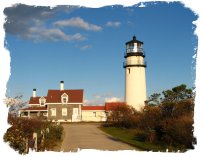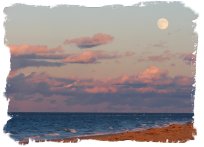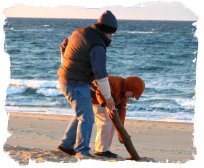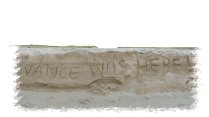Cape Cod National Seashore
Saturday, November 4, 2006The bared and bended arm of Massachusetts - Henry David Thoreau (Cape Cod)
We were headed for the Whaling Museum in New Bedford, when we heard the weather report: Clear today, overcast with chance of rain tomorrow. So we hung a left, and headed out to Cape Cod instead while we had good weather.
To answer your question upfront – no, we didn’t go to Hyannis, nor did we see anyone famous!
 There are several ways you could approach the Cape. It is full of shops and galleries, and you could easily spend weeks browsing thru them all. You could also approach it from a nature standpoint, which is what we opted to do. After a leisurely drive down Hwy 6A, which goes along the western side of the Cape, we stopped in at the Cape Cod National Seashore Visitors Center at Salt Pond. There we visited their museum, and attended a ranger program on Horseshoe Crabs.
There are several ways you could approach the Cape. It is full of shops and galleries, and you could easily spend weeks browsing thru them all. You could also approach it from a nature standpoint, which is what we opted to do. After a leisurely drive down Hwy 6A, which goes along the western side of the Cape, we stopped in at the Cape Cod National Seashore Visitors Center at Salt Pond. There we visited their museum, and attended a ranger program on Horseshoe Crabs. It’s a nice Visitors Center, and you can tell by the size of the parking area that it gets a lot of traffic during the season. This center was unusual in that it had multiple orientation films. We viewed three – one of David Henry Thoreau’s impressions of 19th century Cape Cod, one on how it was formed by glacial activity, and finally, a film on Marconi’s test of the first international wireless communications station, setup near the village of Wellfleet on the Cape.
It’s a nice Visitors Center, and you can tell by the size of the parking area that it gets a lot of traffic during the season. This center was unusual in that it had multiple orientation films. We viewed three – one of David Henry Thoreau’s impressions of 19th century Cape Cod, one on how it was formed by glacial activity, and finally, a film on Marconi’s test of the first international wireless communications station, setup near the village of Wellfleet on the Cape.Marconi realized the potential for radio waves to transmit electronic signals, and developed a device to send Morse Code over the airwaves. Transcontinental electronic communication already existed, as the first undersea cables had been laid in the late 1870’s, one coming ashore very near to his wireless test. However, wireless had the potential to provide communication to ships at sea. He built three test stations, one on Cape Cod, one in Nova Scotia, and one in England. The intention was for the signal from Cape Cod to be relayed to England from the Nova Scotia station, but this proved unnecessary. The first demonstration of the system was a message from President Teddy Roosevelt to King Edward of Great Britain. Ironically, the reply from King Edward had to be relayed by horse to a telegraph station once received at Cape Code via wireless.
 The Atlantic side of the Cape (the ‘back side’) is distinguished by high (80-100 feet), sandy bluffs towering over the beach. The Cape erodes at a rate of about 3 feet a year, with the sand constantly shifting, forming new islands and sandbars. Because of the erosion, structures are constantly having to be moved back or are destroyed – the bluffs at one beach had multiple pipes and cables hanging out of it, where they had obviously once been buried in the earth. The Highlands Cape Cod Lighthouse, the oldest one on the Island, was moved back from the edge of the cliffs just a few years ago to prevent its destruction. The Cape is quite rocky, as it was formed by glacial activity 10-15,000 years ago.
The Atlantic side of the Cape (the ‘back side’) is distinguished by high (80-100 feet), sandy bluffs towering over the beach. The Cape erodes at a rate of about 3 feet a year, with the sand constantly shifting, forming new islands and sandbars. Because of the erosion, structures are constantly having to be moved back or are destroyed – the bluffs at one beach had multiple pipes and cables hanging out of it, where they had obviously once been buried in the earth. The Highlands Cape Cod Lighthouse, the oldest one on the Island, was moved back from the edge of the cliffs just a few years ago to prevent its destruction. The Cape is quite rocky, as it was formed by glacial activity 10-15,000 years ago.Speaking of lighthouses, they were built to help ships avoid the treacherous sandbars that surround the Cape. Like Cape Hatteras, the area is a notorious graveyard for ships, and the Cape is now dotted with lighthouses, navigational buoys, and coast guard stations.
It’s interesting how some historical footnotes follow you around. In Boston, we studied Paul Revere’s ride to Lexington, both from a historical standpoint, and the famous and somewhat fictionalized version in the famous poem by Longfellow. In the poem, Longfellow describes Revere silently rowing across Charleston Harbor, under the guns of the HMS Somerset, a 64 gun Ship of the Line. This short and harrowing trip across the Charles River really did occur to start Revere’s famous journey, although not everything else Longfellow wrote is strictly accurate.
Then he said, "Good night!" and with muffled oar
Silently rowed to the Charlestown shore,
Just as the moon rose over the bay,
Where swinging wide at her moorings lay
The Somerset, British man-of-war;
A phantom ship, with each mast and spar
Across the moon like a prison bar,
And a huge black hulk, that was magnified
By is own reflection in the tide - Longfellow
At the Visitors Center at the tip of Cape Cod, there is an information kiosk describing how the HMS Somerset later wrecked and sank just off the cape after striking a sandbar during a storm. Occasionally timbers from the wreck can be seen on the beach when the sand has washed in a particular way.
The Pilgrims initially landed on Cape Cod in the Mayflower, near the tip at what today is Provincetown. As their actual land petition was for colonizing the mouth of the Hudson (present day New York), they attempted to sail south. However, the ship very nearly foundered in the riptides and shoals between Cape Cod and Nantucket Island, so they turned around and landed on Cape Cod. Hoping to find a suitable spot to build their village, they explored the Cape for several weeks, but never found an area with a sufficient fresh water source (such as a river). Ultimately, they came into the mainland, and founded Plimoth. Ironically Provincetown, the area where they first landed, is now largely a gay and lesbian resort area – quite a change from the strict fundamentalism practiced by the Pilgrims.
Toward the end of the cape, there are a series of sand dunes. These dunes were largely created by the actions of the first European settlers on the cape, who rapidly deforested the area. Losing the stabilizing ground cover, the wind pushed up a long series of sand dunes, which to this day cause problems with burying roads and structures. The first laws against walking on or destroying groundcover on the dunes appeared in the 1660’s, which gives you an idea of the problems the dunes caused. Nearly 400 years later the dunes have not fully recovered – some areas are now wooded and stabilized, but most are not.

We could see where it would be a nice area to visit for an extended stay. Because of the NW orientation of the Cape at it's tip, it's possible to view both a sunset and moonrise over water at the same time. Walking along the beach at dusk; we were treated to a spectacular moonrise with a nearly full moon, silhouetted against a fading pink sky.

Vance really enjoyed his short visit to the beach. It was cold, cold, cold - the wind was blowing, and the temperature hovered not much above freezing. But he wasn't deterred, and played on the sandy banks and on a small sandbar. For all the gee-wizardry of the Game Boys and other modern toys, sometimes all it takes is a good stick to keep a child happy!

Vance:

Near the edge of the park there was a sand dune lookout. Near the last hours of daylight, we went to another beach. My dad took a big stick and wrote “VANCE WAS HERE”. For the last moments at the beach, I took a huge stick and started to collapse the small sand hills on the beach. Finally, we went to the theater and saw Flushed Away!








<< Home